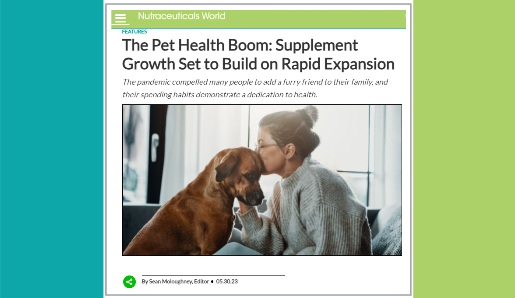This article appeared in the June 2023 edition of Nutraceuticals World.
CLICK HERE to read original article
By Sean Moloughney, Editor
Two-thirds (66%) of U.S. households (86.9 million homes) have a pet, according to the American Pet Products Association (APPA).
Dogs are the most popular pet in the U.S. (65.1 million households), followed by cats (46.5 million households), freshwater fish (11.1 million households), small animals like hamsters, gerbils, rabbits, guinea pigs, chinchillas, mice, rats, and ferrets (6.7 million households), birds (6.1 million households), and reptiles (6 million households).
By generation, Millennials make up the largest percentage of pet owners/parents (33%), followed by Gen X (25%) and Baby Boomers (24%).
Among Millennials who own a pet, 66% have a dog and 59% have a cat, according to a Forbes Advisor 2022 survey. Among Gen X pet owners, 69% have a dog while 54% have a cat; and among Baby Boomers who own a pet, 50% have a dog while 42% have a cat.
Gen Z pet owners (ages 18 to 25) are much more likely than other age groups to have a variety of pets. Among those in this generation with pets, 86% have a dog, 81% have a cat, 46% have a bird, 30% have a hamster or guinea pig, 28% have a rabbit, 26% have fish, 24% have a lizard, and 22% have a turtle.
Spending and the Economy
Spending on all these pets is substantial. Altogether, Americans spent $136.8 billion on their pets in 2022, up 10.68% from 2021 ($123.6 billion), according to APPA data. This includes $58.1 billion on pet food and treats; $31.5 billion on supplies, live animals, and over-the-counter medications; $35.9 billion on veterinary care; and $11.4 billion on other services like boarding, grooming, pet insurance, and training.
Between 2018 and 2022, the amount spent on pets in the U.S. increased by more than 51%, from $90.5 billion to $136.8 billion, per APPA.
COVID-19 factored greatly in the pet health market. Nearly one in five U.S. households added a cat or dog to their home in the first year of the COVID-19 crisis, according to data from the American Society for the Prevention of Cruelty to Animals (ASPCA). This would equate to approximately 23 million American households based on the 2019 U.S. Census.
“This incredibly stressful period motivated many people to foster and adopt animals, as well as further cherish the pets already in their lives,” Matt Bershadker, ASPCA president and CEO said in 2021 when the survey results were released.
According to a Forbes Advisors survey, 78% of pet owners acquired pets during the pandemic: 16% in 2020, 39% in 2021, and 23% in 2022.
As COVID-19 restrictions lifted and consumers returned to work and social activities, there was concern about “rehoming” of those animals. However, ASPCA research indicated the vast majority of households still have their pet in the home (90% for dogs and 85% for cats).
“Pets are still providing their families with joy and comfort, regardless of changes in circumstances, and loving owners continue to recognize and appreciate the essential role pets play in their lives,” Bershadker said.
Bill Bookout, president of the National Animal Supplement Council (NASC), said the surge in pet ownership and buying of related supplies wasn’t an isolated sales spike, but a real expansion of the pet supplements market, which he estimated at approximately $3 billion.
While the 20% growth seen from 2020 to 2021 wasn’t sustainable, future CAGR outlooks range between 3% and 6%. “I think 3-5% is a pretty safe estimate for dog and cat products,” said Bookout. “In this economy that is pretty healthy.”
Many experts have deemed the animal industry as fairly recession-proof. “People will do without things for themselves before they’ll do without things for their pets,” said Bookout. “I know my wife and I are that way with our two cats.”
Product Innovation
Similar to the human dietary supplement market, new product development and innovation in pet supplements is often driven by unique ingredients and new research.
“The animal industry is a fast-follow industry,” said Bookout, “so when you see things that become popular on the human side, that has a tendency to drive and influence innovation on the animal side as well.”
For example, ashwagandha sales are off the charts for both humans and pets. NASC has data on products and ingredients in the pet supplement marketplace from its National Adverse Event Reporting System (NAERS), a post-market surveillance database for NASC member company products.
In addition to identifying potential safety issues, NAERS “allows us to have direct visibility as to what ingredients are becoming popular,” said Bookout, “and ashwagandha in particular is a real up-and-comer.”
Not everything translates from people to animals though, and product form is an essential consideration.
“Palatability is one big difference between the human and animal industries,” said Bookout, noting that several companies have tried to develop gummies for animals but the product ends up sticking to their teeth.
“You can have the greatest product in the world, but if you can’t easily get the animal to consume the product, then people are just not going to give a daily supplement to a dog or a cat. Palatability and animal acceptance are critical.”
As a result, soft chews are a standard delivery form for animal supplements, but fortified treats and snacks are another route of administration.
Regulatory Model
The Dietary Supplement Health and Education Act (DSHEA), which in 1994 amended the Food, Drug and Cosmetic Act to regulate supplements as a separate class of foods, does not apply to animal products.
Instead, animal products are regulated at the federal level by the FDA Center for Veterinary Medicine (CVM), and at the state level, potentially, depending on individual statutes.
Under federal law, animal “foods” contribute to daily nutrition, as part of a complete and balanced diet, such as vitamins and minerals, essential fatty acids, etc. Meanwhile, animal “remedies” are ingredients that haven’t been established as essential to daily nutritional requirements, but do offer structure or function health benefits.
Therefore, ingredients that support a healthy cardiovascular system, or healthy joint function, for example, can be marketed under enforcement discretion, “technically as unapproved drugs of low enforcement priority, provided companies act responsibly,” Bookout said.
Companies must follow current good manufacturing practices (cGMPs), have written quality-control standards, conduct post-market surveillance, and cannot claim to diagnose, prevent, treat, or cure diseases.
The standards that encompass NASC’s quality seal draw from 21 CFR part 111—human dietary supplement standards—plus components of 21 CFR part 507—cGMPs, hazard analysis, and risk-based preventive controls for animal food as required under the Food Safety Modernization Act (FSMA).
“We include the sections for preventive controls and food safety plans,” said Bookout. “So our cGMPs at NASC are a hybrid—equivalent on the human side to part 111 for human dietary supplements and 117 for human food; but dietary supplements are specifically exempt under FSMA from having to follow 117.”
The NASC Quality Seal identifies products from companies that are committed to quality, vigilance, and continuous improvement to promote the wellbeing of companion animals and horses. The Quality Seal program is central to the association’s efforts to help elevate and standardize the animal health supplement industry. To obtain permission to display the Quality Seal on their products and marketing materials, NASC member companies must pass an independent third-party audit every two years, and demonstrate ongoing compliance with the following criteria:
- Have a quality control manual in place that provides written standard operating procedures for production process control;
- Have an adverse event reporting/complaint system in place to monitor and evaluate products in real time;
- Comply with labeling guidelines for all products and all forms of labeling;
- Include on product labels any specific warnings and caution statements for particular ingredients that are recommended by the FDA-CVM and the NASC Scientific Advisory Committee; and
- Submit to random product testing by an independent lab to ensure ingredients meet label claim.
Bookout emphasized that quality is a process of continuous improvement. “Having quality raw materials from trusted suppliers is the beginning step, bolstered by process control as defined by cGMPs, verified by testing of finished products to ensure everything upstream is operating properly. That’s the key to quality products,” he said.
“Our mission and our operating foundation is that quality is always a journey, never a destination, because we always know more tomorrow than we know today. It’s always a process of continuous improvement.”
CBD Safety
Bookout said his opinion of CBD has changed over the years. When the 2018 Farm Bill passed, effectively descheduling industrial hemp (cannabis containing less than .3% THC on a dry weight basis) from the definition of marijuana under the Controlled Substances Act, Bookout thought FDA would take action.
“They had the authority to do so. I assumed FDA was going to act both on the human side as well as the animal side, and take a stand that CBD was not an approved ingredient for use in animal products.
But that didn’t happen. “FDA issued a few warning letters, but overall there was never any real strong enforcement position taken,” Bookout noted.
As a result, consumer demand skyrocketed and industry responded with new product development for humans and animals.
“So my opinion changed,” said Bookout. “We (NASC and the industry) could not wait for FDA or Congress to act and come out with a responsible path forward. So we as an organization, on behalf of our members in the industry, were going to define what we thought a responsible path forward would be. We’ve done that for other products that are marketed under enforcement discretion; we saw no reason why we couldn’t accomplish the same thing for CBD. And that’s exactly what we’ve done.”
In addition to a recent 90-day cannabinoid study in healthy dogs that demonstrated the safety of CBD at 5 mg per kg/body weight, NASC’s post market surveillance data (NAERS) has tracked the application of hemp derivatives to conclude these substances are indeed safe under proper quality control measures.
Relationships with Regulators
NASC and the pet supplement industry have been lauded for their good working relationship with FDA.
“We do have a strong, healthy relationship with the regulators at both the state and federal level, but particularly with respect to FDA,” Bookout said. “We weren’t afraid to go to FDA initially and genuinely listen to what their concerns were.”
“When we first met with the agency they said: ‘We don’t know how many products are out there. We don’t know how many companies are out there. We don’t know how many ingredients are out there. We don’t know what kind of claims people are making, and we don’t have any data on safety to know if any of these substances are safe or if they pose undue risk to animals.’”
Bookout said he found senior-level FDA officials “very solutions-driven.”
“We went to FDA and we said: ‘we heard you, this is what we can do, and this is the plan that we have, and we’ll work with you in an advisory capacity if not an official capacity.’ We always kept FDA posted and so we acted very transparently. We went to FDA routinely, at least twice a year, sometimes more, and engaged with the agency as well as state regulators.”
Bookout credited the regulatory agencies for their “cooperative approach and willingness to work with us. and I really can’t overemphasize that.” Still, it took at least five years to establish credibility with the regulators, he added.
“If I could summarize in one word why we’ve been successful it’s ‘credibility.’ We walked our talk and we’ve been open and transparent. In my opinion—and I’m biased, admittedly—we’re a model for any industry of what a public-private partnership could be to pave a responsible path forward to a problem and cooperatively identify an approach that was beneficial for all stakeholders, not least importantly the animals. And I stand on our results to support that statement.”


